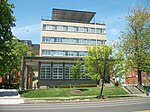Fargo Estate Historic District

Fargo Estate Historic District is a national historic district located at Buffalo, Erie County, New York. The district encompasses 390 contributing buildings, 1 contributing site, and 2 contributing objects on the Lower West Side of Buffalo. This predominantly residential district developed between about 1850 and 1930, and includes notable examples of Italianate, Queen Anne, Colonial Revival, and American Craftsman style architecture. A 2 1/2-block section of the neighborhood was developed between about 1888 and 1910 on the former "Fargo Estate," the home of William Fargo. Located in the district are the separately listed Engine House No. 2 and Hook and Ladder No. 9 and a section of the Delaware Park-Front Park System (Porter Avenue). Other notable buildings include the Benedict House (c. 1890), Plymouth Methodist Episcopal Church / now Karpeles Library and Manuscript Museum (1912), and West Side Presbyterian Church / now Iglesia de Cristo Misionera (1882).It was listed on the National Register of Historic Places in 2016.
Excerpt from the Wikipedia article Fargo Estate Historic District (License: CC BY-SA 3.0, Authors, Images).Fargo Estate Historic District
Prospect Avenue, Buffalo
Geographical coordinates (GPS) Address Nearby Places Show on map
Geographical coordinates (GPS)
| Latitude | Longitude |
|---|---|
| N 42.900833333333 ° | E -78.890555555556 ° |
Address
Prospect Avenue 500
14201 Buffalo
New York, United States
Open on Google Maps









